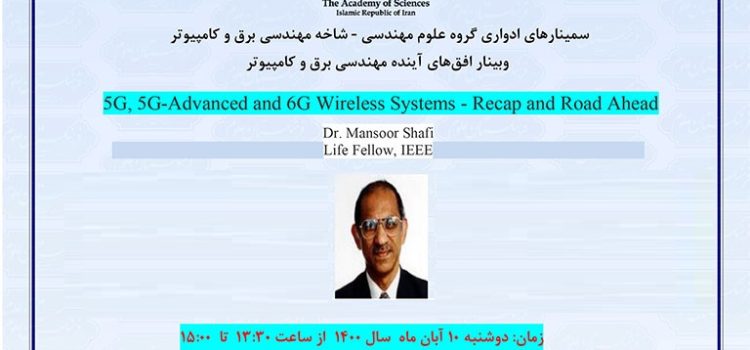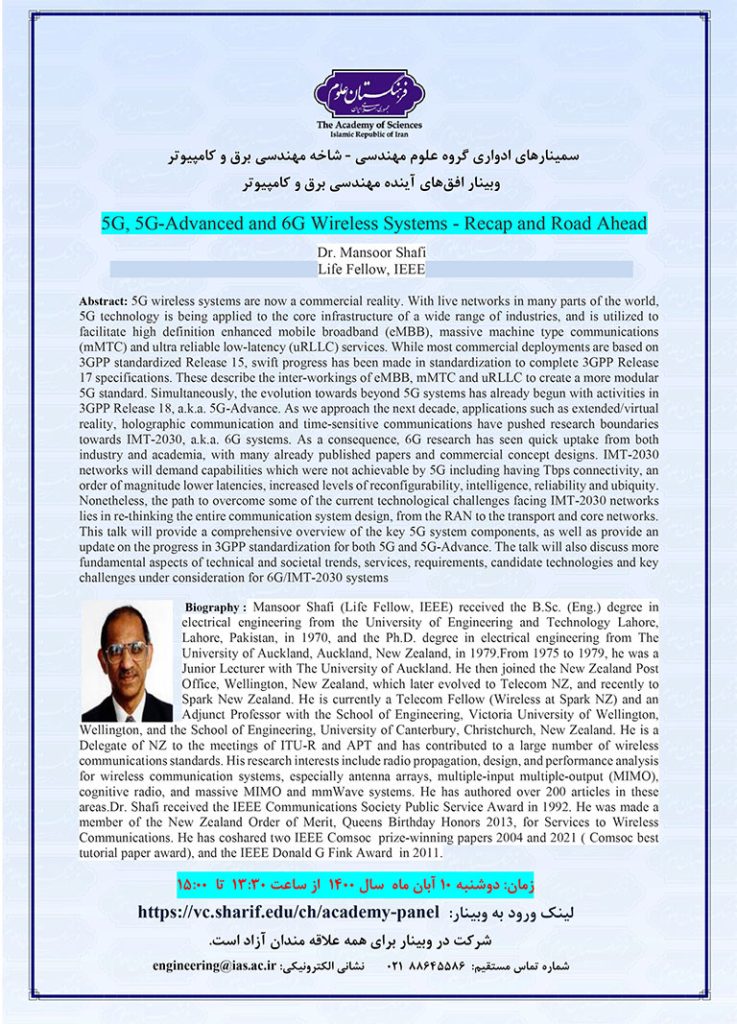
وبینار “افق های آینده مهندسی برق و کامپیوتر” با موضوع «۵G, 5G-Advanced and 6G Wireless Systems – Recap and Road Ahead »؛ در روز دوشنبه مورخ ۱۰ آبان ماه سال ۱۴۰۰ از ساعت ۱۳:۳۰ تا ۱۵:۰۰ با سخنرانی دکتر منصور شافی، عضو مادام العمر IEEE، توسط شاخه مهندسی برق و کامپیوتر گروه علوم مهندسی فرهنگستان علوم برگزار میشود. علاقه مندان میتوانند از طریق لینک زیر وارد محیط وبینار شوند.
لینک ورود به وبینار: https://vc.sharif.edu/ch/academy-panel
بیوگرافی:
Mansoor Shafi (Life Fellow, IEEE) received the B.Sc. (Eng.) degree in electrical engineering from the University of Engineering and Technology Lahore, Lahore, Pakistan, in 1970, and the Ph.D. degree in electrical engineering from The University of Auckland, Auckland, New Zealand, in 1979.From 1975 to 1979, he was a Junior Lecturer with The University of Auckland. He then joined the New Zealand Post Office, Wellington, New Zealand, which later evolved to Telecom NZ, and recently to Spark New Zealand. He is currently a Telecom Fellow (Wireless at Spark NZ) and an Adjunct Professor with the School of Engineering, Victoria University of Wellington, Wellington, and the School of Engineering, University of Canterbury, Christchurch, New Zealand. He is a Delegate of NZ to the meetings of ITU-R and APT and has contributed to a large number of wireless communications standards. His research interests include radio propagation, design, and performance analysis for wireless communication systems, especially antenna arrays, multiple-input multiple-output (MIMO), cognitive radio, and massive MIMO and mmWave systems. He has authored over 200 articles in these areas.Dr. Shafi received the IEEE Communications Society Public Service Award in 1992. He was made a member of the New Zealand Order of Merit, Queens Birthday Honors 2013, for Services to Wireless Communications. He has coshared two IEEE Comsoc prize-winning papers 2004 and 2021 ( Comsoc best tutorial paper award), and the IEEE Donald G Fink Award in 2011.
چکیده:
۵G wireless systems are now a commercial reality. With live networks in many parts of the world, 5G technology is being applied to the core infrastructure of a wide range of industries, and is utilized to facilitate high definition enhanced mobile broadband (eMBB), massive machine type communications (mMTC) and ultra reliable low-latency (uRLLC) services. While most commercial deployments are based on 3GPP standardized Release 15, swift progress has been made in standardization to complete 3GPP Release 17 specifications. These describe the inter-workings of eMBB, mMTC and uRLLC to create a more modular 5G standard. Simultaneously, the evolution towards beyond 5G systems has already begun with activities in 3GPP Release 18, a.k.a. 5G-Advance. As we approach the next decade, applications such as extended/virtual reality, holographic communication and time-sensitive communications have pushed research boundaries towards IMT-2030, a.k.a. 6G systems. As a consequence, 6G research has seen quick uptake from both industry and academia, with many already published papers and commercial concept designs. IMT-2030 networks will demand capabilities which were not achievable by 5G including having Tbps connectivity, an order of magnitude lower latencies, increased levels of reconfigurability, intelligence, reliability and ubiquity. Nonetheless, the path to overcome some of the current technological challenges facing IMT-2030 networks lies in re-thinking the entire communication system design, from the RAN to the transport and core networks. This talk will provide a comprehensive overview of the key 5G system components, as well as provide an update on the progress in 3GPP standardization for both 5G and 5G-Advance. The talk will also discuss more fundamental aspects of technical and societal trends, services, requirements, candidate technologies and key challenges under consideration for 6G/IMT-2030 systems.
